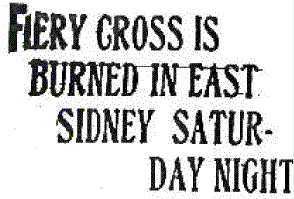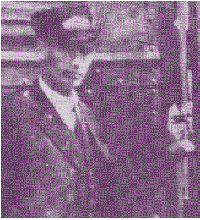|
Ku Klux Klan
The KKK, a
group of white secret societies, traces its roots back to Pulaski, Tennessee, circa 1865,
when a group of Confederate Army veterans organized to oppose the advancement of blacks,
Jews, and other minority groups. They concealed their identities beneath robes and hoods,
and often used violence and terrorism in an attempt to achieve their aims. Crosses were
burned to intimidate minorities and non-members. After the Civil War they threatened, beat, and murdered
many blacks and their white sympathizers. Its membership grew rapidly throughout the South
until the passage of the Force Bill (1871) gave the President the authority to use federal
troops against the Klan. Following this action, they almost disappeared, resurfacing again
in the early 1900s.
The new Klan, organized by a former
Methodist clergyman in 1915, targeted groups it considered to be un-American, including
blacks, immigrants, Jews and Roman Catholics. By the 1920s, it had over 2 million members
nationwide and had become a powerful force across the South, in the West and Northern U.S.
It was particularly strong in Colorado, Kansas, Maine, Oregon, Indiana and Ohio. Its
national demise in 1944 was brought about because of disagreement among the membership on
the means to impose their vision of America on society. Many members objected to the
terrorist tactics, beatings, whippings, murders, and hangings that identified the Klan as
an unlawful hate group.
In 1946, an Atlanta physician reactivated the Klan and ushered in
another period of violence and death. Klan terrorist attacks in the 1960s took many lives,
including 3 civil rights workers in Mississippi, a bombed church in Alabama in which 4
black girls were killed, and, in 1979, the killing of 5 anti-Klan demonstrators in North
Carolina.
"The Sidney Daily News" on April 28, 1923, reported
on the Ku Klux Klan at Anna. "We have waited a week to see how sentiment was
running in regard to the demonstration of the Klu[sic] Klux Klan in our village,
before making any report. The result is, we find the citizens pretty much wrought up over
the affair. About 95 per cent being outspoken against such demonstrations. The few who are
promoting this Klan business are fast losing the respect and confidence of their friends
and neighbors and are gaining nothing. We do not believe in paying any stranger or
organization coming into our community $10 to prove our Americanism. Let our actions prove
we are 100 per cent. We can do it by being loyal citizens to our country, to our stage and
to our community; loyal to God, to our church and its teachings; loyal to our Brotherhood
obligations; and above all, loyal to our home and family. What higher degree of loyalty or
Americanism can any one demand? What Klansman in Anna or elsewhere can measure up to any
higher standard?

"The Sidney Daily News" also
reported on May 16, 1923, that a cross was burned in East Sidney (Brooklyn Avenue area, east of the
river). The June 16, 1923, edition stated that the first cross had been burned at
Wapakoneta, in Auglaize County.
On August 16, 1923, the local newspaper gave the following account. "All roads led to the Shelby County fair grounds Wednesday afternoon and evening when
the word was passed around that the Ku Klux Klan would have a meeting during the evening
and administer of the oath of a Klansman to a number of new members. Many came from a
distance and by the time the ceremonies were ready to begin the grand stand at the
fairgrounds was packed to overflowing the fence around the ring was lined with people and
hundred of autos were parked throughout the fair grounds. It was estimated that at least
10,000 people were on the grounds."
The newspaper described the taking of the oath and ceremony, then
concluded with "...three big fiery crosses were burned, several other lighted
crosses appeared in view before the grand stand and the celebration ended by the
appearance of a small school house and the American flag in fireworks."
 Harry Miller worked as a
conductor and brakeman for the Western Ohio Traction Company from 1917 to 1929. He is
pictured at right with what he called the KKK Special. According to Harry, "We had
what we called a KKK car and that group would have a big party between St. Marys and
Celina at Sandy Beach...We had to go out there for pick-up...the car traveled to Ku Klux
Klan rallies between the two towns...they would burn a cross out there and have a big
time." Harry Miller worked as a
conductor and brakeman for the Western Ohio Traction Company from 1917 to 1929. He is
pictured at right with what he called the KKK Special. According to Harry, "We had
what we called a KKK car and that group would have a big party between St. Marys and
Celina at Sandy Beach...We had to go out there for pick-up...the car traveled to Ku Klux
Klan rallies between the two towns...they would burn a cross out there and have a big
time."
Today, the Klan is
splintered into many different factions all espousing the same hate message to blacks,
Jews, immigrants and other minorities. Roman Catholics have been dropped from the target
list. It is an alienated organization with a membership of approximately 6,000
individuals; primarily in the South.
As recently as December,
1997, someone apparently tried to burn a cross. It was planted next to the National
Afro-American Museum and Cultural Center in Wilberforce, Ohio. Racial slurs, KKK and a
swastika were written on the cross which was made of lumber and stood about five feet
tall. The museum opened in 1988 and its mission is to educate others about Afro-American
history and culture. Said director John Fleming, "...it never occurred to me that
in the ‘90s in Ohio that a cross would be burned at the place where I worked."
'Black History' segment
written in June, 1998 by David Lodge
[ Back to Black History Index ]
|

